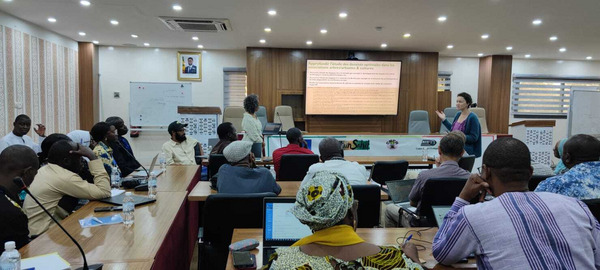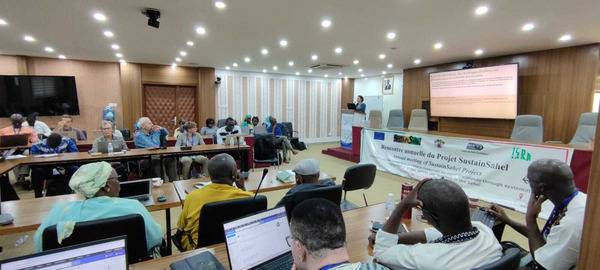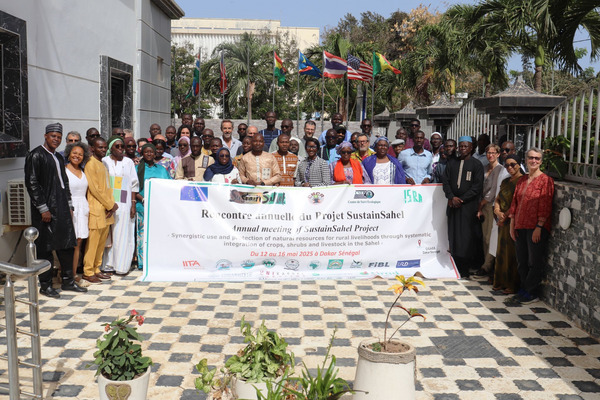These recommendations were co-created through cross-country working groups that brought together representatives from different project partners. They aim to strengthen scientific understanding and contextual adaptation of agroforestry practices and contribute to more resilient and sustainable systems.
The recommendations are based on findings from national research institutions, IER and IPR/IFRA (Mali), UNB and INERA (Burkina Faso), CSE (Senegal), ISRA (Senegal), FiBL (Switzerland), U-HOH and Uni Kassel (Germany), in partnership with CIRAD, IRD, and local producer groups.
→ Download: The Complete Recommendations to Researchers (in French) are available here
→ Final Recommendations to Farmers here
→ Final Recommendations to Policy Makers here
Overall Recommendations for further research
- Deepen the understanding of optimal tree and shrub densities in tree–crop combinations and agroecological conditions.
- Specify species-specific pruning practices (frequency, timing, intensity) and analyse short- and long-term agronomic and ecological impacts.
- Improve propagation and multiplications methods of key woody species to ensure seed availability at scale.
- Refine applications techniques for prunings (e.g. incorporation, mulching) according to soil and climate conditions, species used, and associated crops.
- Deepen the understanding of the effects of prunings on nutrient recycling and their impact on soil properties.
- Further investigate the effects of woody species on the availability of water, nutrients, and soil biodiversity.
- Deepen the understanding of greenhouse gas fluxes at the scale of agroforestry systems (e. g. Faidherbia albida).
- Further study the effects of exclosures (fenced-off areas) on herbaceous biomass production and biodiversity in parklands.
- Advance research in nutritional value and antiparasitic effects of woody fodder species to control gastrointestinal nematodes.
- Promote and participate in the implementation of agroforestry practices in zones suitable for the identified potential.
- Promote and contribute to improved monitoring of crop conditions in the Sahel using remote sensing and modelling tools and combine it with on-farm data.
- Deepen methods for evaluating the performance of agroforestry parklands.
- Analyse socio-economic trade-offs and adoption dynamics of different agroforestry practices.
Woody plant-crop interactions and system design
- Further specify optimal densities of woody species in association with crops, considering tree development, root architecture, canopy shading, and interspecific competition under varying agro-climatic and edaphic conditions.
- Continue to examine species-specific effects of shrubs and trees on crop productivity, soil water dynamics, and nutrient cycling.
- Further investigate the influence of proximity to woody plants (e.g. Faidherbia albida, Piliostigma reticulatum, Guiera senegalensis) on weed suppression, particularly Strigahermonthica, and on soil moisture retention.
Research findings
→ Studies conducted by ISRA and IRD in Senegal indicate significant increases in millet yield and reductions in Striga infestation under Faidherbia canopy.
Pruning management and long-term Impact assessment
- Define species-specific pruning regimes (frequency, timing, intensity) and their short- and long-term agronomic and ecological impacts.
- Quantify the effect of pruning on biomass productivity, Striga emergence, and nutrient cycling, especially for F. albida, G. sepium, and P. reticulatum.
- Assess the cumulative impact of repeated pruning on tree health and resilience.
Research findings
→ Results from ISRA (Senegal) indicated that heavy pruning of F. albida led to a fourfold increase in S. hermonthica infestation, demonstrating the need to adjust pruning strategies by species and context.
Organic input application strategies and biomass dynamics
- Develop recommendations on the use of prunings as mulch or compost, including burial depth, decomposition dynamics, and compatibility with mineral fertilisers.
- Characterise species-specific decomposition rates, nutrient release timing, and mineralisation patterns under varying soil and climate conditions.
Research findings
→ At the Sikasso site in Mali, the prunings of Gliricidia sepium and Leucaena leucocephala showed the highest decomposition rates, reaching 70% and 61% respectively within 30 days, significantly faster than Parkia biglobosa (40%), Vitellaria paradoxa (38%), and Guiera senegalensis (33%). (IER)
Soil fertility, structure, and water relations
- Monitor the effects of biomass inputs on bulk density, porosity, infiltration rates, aggregate stability, and labile carbon.
- Quantify the contribution of surface composting to reducing erosion and enhancing soil water storage.
- Analyze how tree root systems and mulch treatments affect soil temperature and water retention at different depths.
Research findings
→ Results from Mali (IER) showed that surface composting with woody biomass reduced bulk density by 23% and increased porosity by 28%.
Greenhouse gas fluxes and agroecosystem carbon dynamics
- Continue long-term monitoring of CO₂ fluxes at the agroforestry system level.
- Examine seasonal patterns in net ecosystem exchange, including dry-season uptake by woody perennials and nocturnal water and carbon dynamics.
- Integrate biophysical monitoring into simulation models to predict system responses to climatic variability.
Research findings
→ In Senegal, IRD and CIRAD observed consistent dry-season carbon uptake by Faidherbia and confirmed nocturnal upward water movement in surface soil layers.
Biodiversity, soil fauna, and herbaceous regeneration
- Investigate how shrub cover, mulch composition, and fencing affect soil macrofauna diversity, regeneration of herbaceous species, and ecosystem services.
- Identify fauna species associated with mulch decomposition and their role in nutrient cycling.
- Study the effects of fallowing under tree canopy and the duration of enclosure for biodiversity recovery.
Research findings
→ ISRA (Senegal) reported a 283% increase in herbaceous biomass and significantly greater species richness under Balanites aegyptiaca in enclosed pastures.
Woody fodder for livestock nutrition and health
- Incorporate woody fodder into small ruminant diets at an optimal rate of 30%-40%, as this composition improves protein and energy intake and supports weight gain.
- Continue research on the antiparasitic effects of tree leaves (e. g. A. digitata, K. senegalensis, B. aegyptiaca).
- Further investigate seasonal variation in dry matter, protein, energy, and secondary compounds in woody fodders during wet and dry seasons.
Remote sensing and system modelling
- Use drones and satellite imagery (e.g. Sentinel-2) to assess spatial variability in vegetation cover, yield prediction, and biomass distribution.
- Calibrate and scale models such as LUCIA for simulating effects of organic inputs and shrub presence on crop yields.
- Combine modelling with ground-truthing data across agroforestry and cereal–legume systems.
Research findings
→ The Random Forest approach used by UHOH achieved 73% validation accuracy in predicting millet vegetation cover.
Socio-economic analysis and adoption research
- Build on existing RCT setups in Senegal and Mali to assess long-term livelihood impacts of agroforestry interventions (in 2027), where real-world causal evidence is currently lacking.
- Quantify the effects of better availability of shrub planting materials on further enhancing adoption and productivity gains.
- Examine potential trade-offs or synergies between shrub integration/other agroecological practices and labour requirements.
- Use survey data to identify optimal bundling strategies of synergistic practices for enhancing productivity and resilience.






 tap and then scroll down to the Add to Home Screen command.
tap and then scroll down to the Add to Home Screen command.